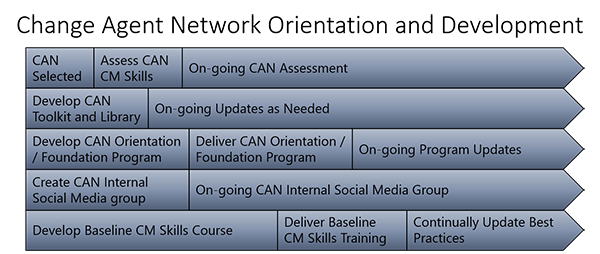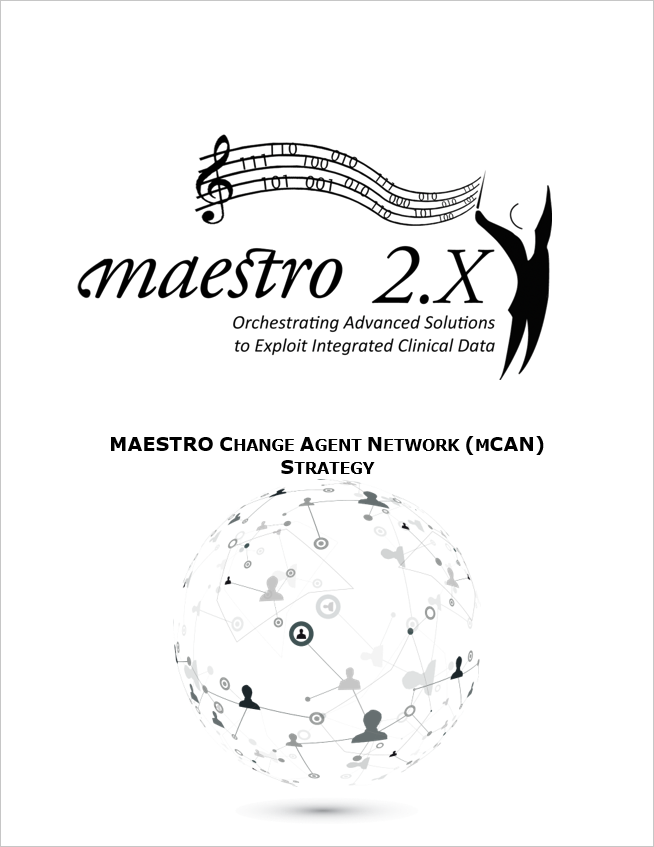Project Documents / Samples
Change Agent Network
What is a Change Agent Network
The term Change Agent Network has become a universal term to describe a core group of people who facilitate a change, transition, or transformation initiative. Those participants in the group may be called Change Leaders, Change Champions, Transition Leaders, Expert Users, Change Leads, Change Ambassadors, or other similar titles. The term Network may or may not always be an accurate description of how they are organized or structured. How the change agents are organized may vary. There are many possibilities in how the group is structured. Instead of be called a Network, they may be called a team, cadre, group, etc. Regardless of how they are organized or labeled, Change Agent Networks as a tool of change have many common elements. They should also be as unique as the projects or initiatives they are serving.
A Change Agent Network is usually formed by the Project / Change Management team with the support of the sponsors and the target business units. The usual scenario is a change initiative that is significant to the business and requires frontline resources to directly assist in and facilitate the implementation of the change and the transition to the new way to working. The members of the network serve numerous roles. They facilitate communications in both directions; between the project / change team and those who are being directly impacted. They deliver messages in both directions providing the project / change team and also sponsors and business executives a first hand information about how the change is being received and assimilated. There are other functions besides communications. The change agents also need to be cheerleaders and active proponents of the change. They must be able to face adversity and deal with resistance in many forms. Change agents must be knowledgeable about the business and the impact of the change. They must be able to sell the benefits and justify the "costs" to those being impacted.
What are the Benefits of a Change Agent Network
Change Agent Networks deliver benefits. Specifically, Change Agents::
- Conduct themselves as Champions of the project in their represented areas
- Have a detailed understanding of attitudes of the various stakeholders and their perception of the change
- Provide a local perspective in change, communications, and engagement planning
- Assist Communications/CM team with content development for Case for Change messaging
- Provide valuable input to people readiness assessment
- Assist in the delivery of key program messages
- Contribute towards risk mitigation by reporting issues, risks, and concerns on time
- Provide realistic assessments of change acceptance and assimilation
When Do You Need a Change Agent Network
With so many benefits, establishing a Change Agent Network would seem to be mandatory. Not every project or initiative may need a Change Agent Network. If it does appear to be needed, there are a number of considerations as to how it should be structured and how formal or informal it should be. These are some of the common considerations when determining the need for a Change Agent Network:
- What is the size and nature of the change impact of the initiative / project?
- How is it physically distributed across the organization in terms of business units, locations, etc.?
- How is it being deployed; big bang or phased rollout?
- What is the impact on on-going business operations? Does deployment coincide with peak volumes, year-end, etc.?
- What is the current level of organizational change readiness for the anticipated impact?
- What is the people readiness for those being impacted?
- Are there other competing change initiatives impacting the same audience or other major change efforts underway that may dilute the effort?
- To what extent is there resistance to this change, where is it potentially most likely to occur, and what are the root causes of this resistance?
- What is the recent history of change management within the organization, what are the key lessons learned, and what has been or will be done?
How Should a Change Agent Network Be Structured
The size of the project / initiative determines the size of the Change Agent Network. Size many times creates a need for a formal structure. In these cases the Change Agent Network may have up to three levels: Change Owners, Change Leaders, and Change Agents. These typically correspond to Executive Level Management, Middle / First Line Management, and Senior Staff. The diagram below shows how these resource could be aligned with the business units and interact with program and change management.
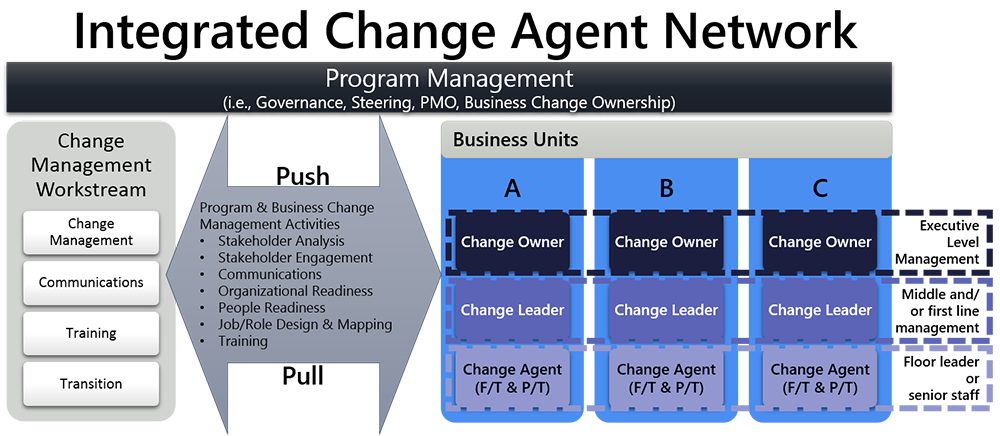
There are different ways of organizing the Change Agent Network within this structure. The Change Agent Network can be organized with a small core team, a large core team, or as a coalition of teams as shown in the diagrams below.
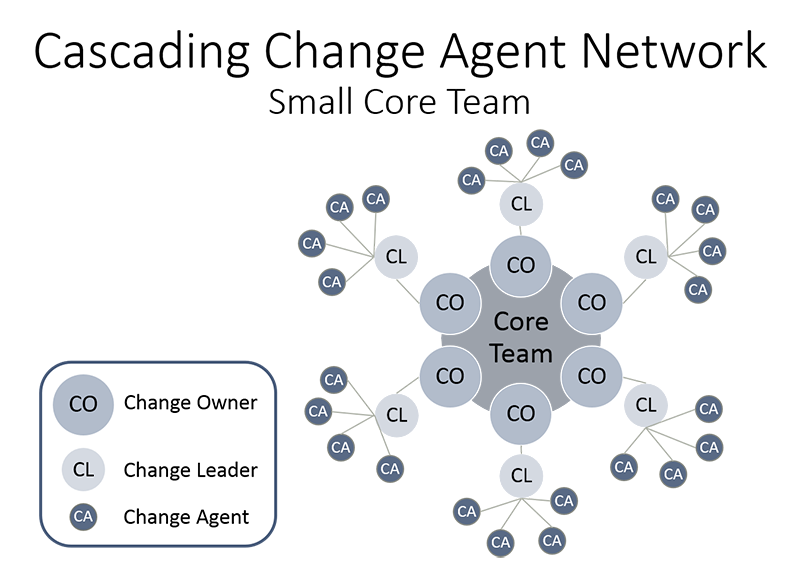
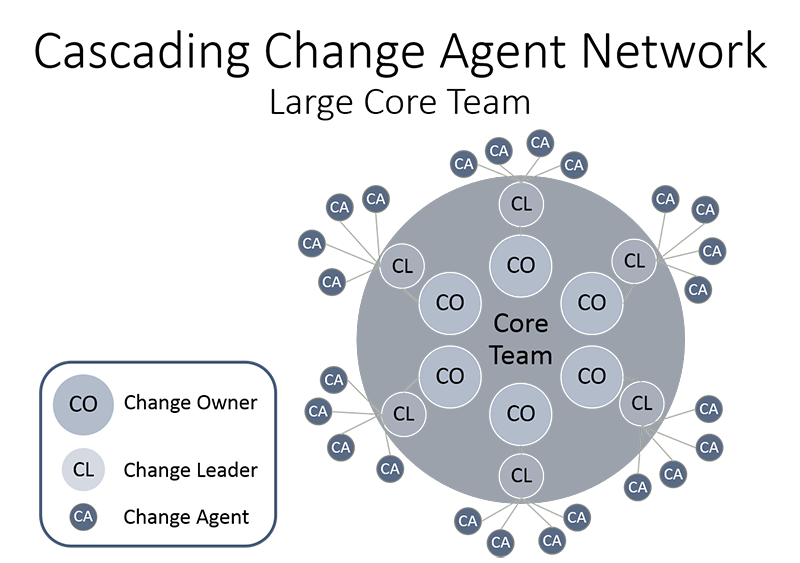
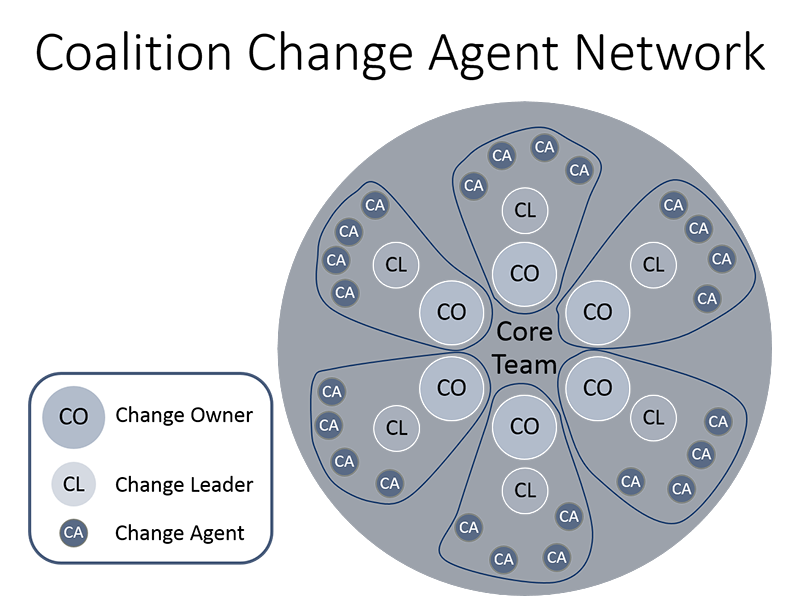
Change Agent Networks can also be structured and organized other ways. The example below is a matrix structure. It shows how business experts are used to staff project cross-functional work teams. The Change Agents are drawn from the workstreams. As workstreams deploy, change agents are assigned to work with the impacted business unit(s). They may work solely within the business unit or assist other business units when their workstream impacts two or more business units.
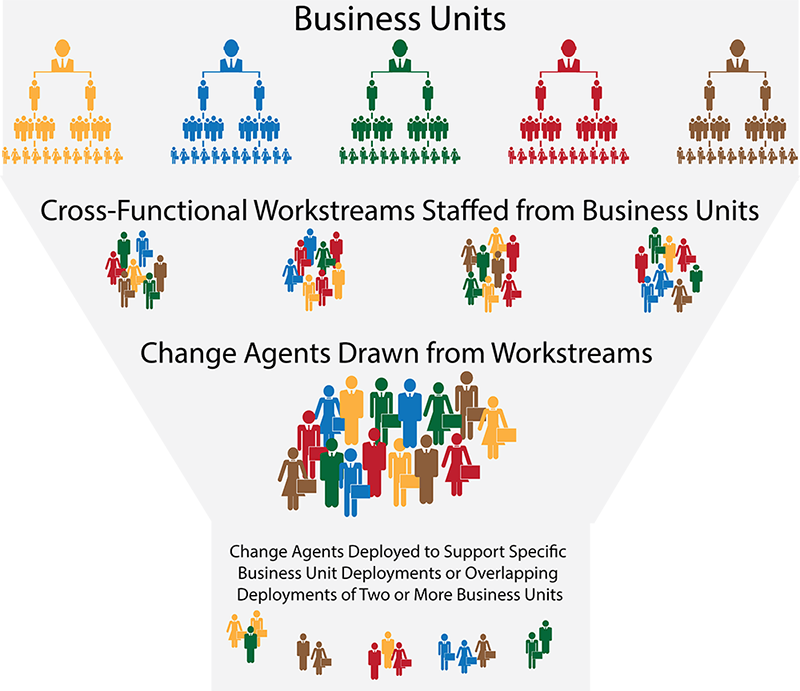
What Skills / Knowledge Should a Change Agent Possess
The skills and knowledge a Change Agent needs will vary depending on the company, business unit, stakeholder personalities, initiative importance, organizational culture, organizational change maturity, people readiness, and similar factors. Also, the change agent's maturity, time in the workforce, experience, and other personal demographics will have an impact on their ability. Probably the most important first step is to identify all of the skills and knowledge that Change Agents should have and rank them as to their importance. This can be used to evaluate the skillset of individual nominees for the role. Also, taken in aggregate they can provide useful gap data that shows where you need to bring skills levels up across all Change Agents.
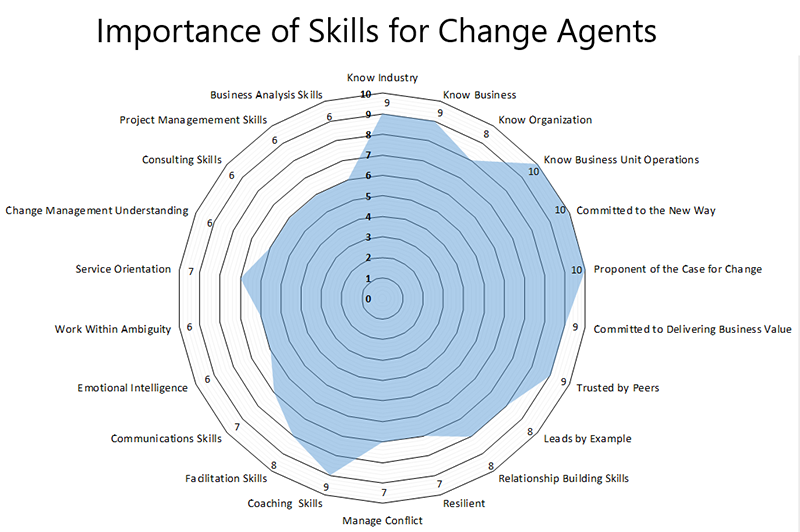
Having an sense of overall skill levels provides two opportunities. First, if skills within a particular area are not as high as they should be you can deliver baseline training. The same applies to individual skill rankings. You can provide training courses for you Change Agents that they can take to improve their knowledge and skills in particular areas. The second opportunity is the ability to "partner" a Change Agent with a lower level of skill with another Change Agent with a higher level of proficiency. This balances the team and also provides a mentoring relationship to bring knowledge and skill levels up.
How Do You Prepare Your Change Agents
It is important to provide your Change Agents with the tools and resources they will need. In addition to skills and knowledge development, the Change Agents need the information and messages they will be delivering. This includes assets such as presentations, handouts, and so forth. It is usually best to provide some sort of introductory orientation. However, it is important to also have regular meetings to communicate updates and obtain feedback from the Change Agents. Any toolkits or libraries need to be maintained. If you are using an enterprise social media group for your Change Agents you will need to establish some guidelines and best practices around how they can leverage it. The diagram below shows an example of a Change Agent Network Orientation Roadmap.
